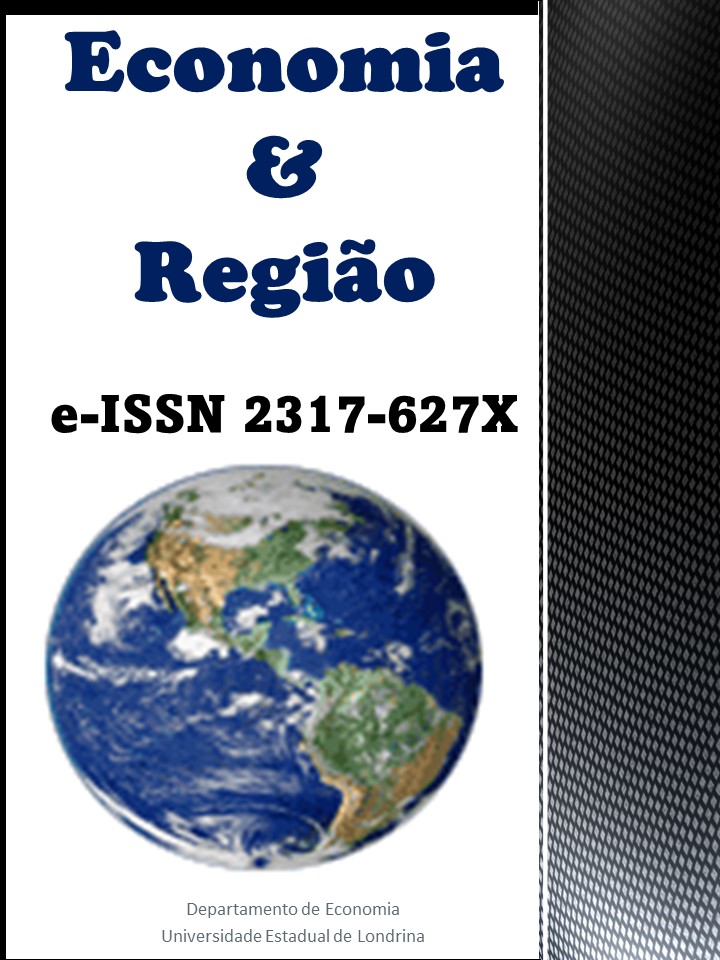Sectoral analysis and identification of key sectors in MATOPIBA: an input-product approach
DOI:
https://doi.org/10.5433/2317-627X.2022v10n3p194Palavras-chave:
insumo-produto, matopibaResumo
The present study obtained the sectorial and intersectoral effects, in relation to greenhouse gas (GHG) emissions, through the realization of the ABC Plan in the MATOPIBA region. A Hybrid Inter-Reginal Input-Output model focusing on the breakdown of the MATOPIBA region was built and operationalized for this purpose. Two scenarios were created with different levels of GHG emissions resulting from the implementation (or not) of the ABC Plan in the region. The results show the importance that the actions of the ABC Plan brought to the study region, the main key sectors for the control of GHG emissions in the region, in addition to corroborating the permanence of pro-environmental actions in MATOPIBA
Downloads
Referências
AGROSATÉLITE GEOTECNOLOGIA APLICADA. Análise geoespacial da dinâmica das culturas anuais no bioma cerrado: 2000 a 2014. Florianópolis: Agrosatélite, 2015.
AGROSATÉLITE GEOTECNOLOGIA APLICADA. Análise geoespacial da soja no bioma cerrado: dinâmica da expansão: aptidão agrícola da soja: sistema de avaliação para compensação financeira: 2001 a 2019. Florianópolis: Agrosatélite, 2020.
ALCÁNTARA, V.; PADILLA, E. "Key" sectors in final energy consumption: an input-output application to the Spanish case. Energy Economics, Guildford, n. 31, p. 1673-1678, 2003.
ANGELO, C. Brazil's Fund Low-Carbon Agriculture Lies Fallow. Nature, London, p. 1-2, 2012. DOI 10.1038/nature.2012.11111.
AZEVEDO JUNIOR, W. C.; RODRIGUES, M.; SILVA, D. C. C. Does agricultural efficiency contribute to slowdown of deforestation in the Brazilian Legal Amazon? Journal for Nature Conservation, Munich, v. 65, p. 126092, 2022.
AZEVEDO, T. R. et al. SEEG initiative estimates of Brazilian greenhouse gas emissions from 1970 to 2015. Scientific Data, London, v. 5, p. 180045, 2018. DOI 10.1038/sdata.2018.45.
BASTOS LIMA, M. G.; PERSSON, U. Martin. Commodity-centric landscape governance as a double-edged sword: The case of soy and the cerrado working group in Brazil. Frontiers in Forests and Global Change, Lausanne, v. 3, p. 27, 2020.
BRASIL. Ministério da Agricultura, Pecuária e Abastecimento. Adoção e mitigação de gases de efeito estufa pelas tecnologias do plano setorial de mitigação e adaptação às mudanças climáticas (Plano ABC). Brasília: MAPA, 2018.
BRASIL. Ministério da Agricultura, Pecuária e Abastecimento. Brasil projeções do agronegócio 2019/2020 a 2029/2030. Brasília: MAPA, 2020.
BRASIL. Ministério da Agricultura, Pecuária e Abastecimento. Plano setorial para adaptação à mudança do clima e baixa emissão de carbono na agropecuária com vistas ao desenvolvimento sustentável (2020-2030): visão estratégica para um novo ciclo. Brasília: MAPA, 2021.
BROOKS J. Brazilian agriculture: balancing growth with the need for equality and sustainability. EuroChoices, [s. l.], v. 16, n. 1, p. 32-36, 2017. DOI10.1111/1746-692x.12148.
CARVALHO T. S.; PEROBELLI F. S. Avaliação da intensidade de emissões de co2 setoriais e na estrutura de exportações: um modelo inter-regional de insumo-produto São Paulo/Restante do Brasil. Economia Aplicada, São Paulo. v. 13. n. 1. p. 99-120, jan./mar. 2009.
CONAB - COMPANHIA NACIONAL DE ABASTECIMENTO. Acompanhamento da safra brasileira de grãos: primeiro levantamento: safra 2020/21. Brasília: Conab, 2020. (Observatório agrícola, v. 8, n. 1).
EMBRAPA - EMPRESA BRASILEIRA DE PESQUISA AGROPECUÁRIA. Evolução e qualidade da pecuária brasileira. Brasília: Embrapa, 2017.
EMBRAPA - EMPRESA BRASILEIRA DE PESQUISA AGROPECUÁRIA. MATOPIBA, delimitação, caracterização, desafios e oportunidades para o desenvolvimento Bahia. Brasília: Embrapa, 2015.
EMBRAPA - EMPRESA BRASILEIRA DE PESQUISA AGROPECUÁRIA. Visão 2030: o futuro da agricultura brasileira. Brasília: Embrapa, 2018.
FIAN INTERNACIONAL The human and environmental cost of land business: the case of MATOPIBA, Brazil. Heidelberg: Fian, 2018.
FREITAS, F. L. M. Brazilian public protection regulations and the preservation of ecosystem services and biodiversity. 2019. Tese (Doutorado) - KTH Royal Institute of Technology, Stockholm, 2019.
HADDAD, E. A.; GONÇALVES JUNIOR, C. A.; NASCIMENTO, T. B. Matriz interestadual de insumo-produto para o Brasil: uma aplicação do método IIOAS. Revista Brasileira de Estudos Regionais e Urbanos, Curitiba, v. 11, n. 4, p. 424-446, 2017.
HILGEMBERG, E. M. Quantificação e efeitos econômicos do controle de emissões de co2 decorrentes do uso de gás natural, álccol e derivados de petróleo no Brasil: um modelo interregional de insumo-produto". 2005. Tese (Doutorado em Economia Aplicada) - Escola Superior de Agricultura Luiz de Queiroz, Universidade de São Paulo, São Paulo, 2004.
IBGE. Contas Regionais 2015: queda no PIB atinge todas as unidades da federação pela primeira vez na série. Rio de Janeiro: IBGE, 2017. Disponível em: https://agenciadenoticias.ibge.gov.br/agencia-sala-de-imprensa/2013-agencia-de- noticias/releases/17999-contas-regionais-2015-queda-no-pib-atinge-todas-as-unidades-da-federacao-pela- primeira-vez-na-serie. Acesso em: 25 jan. 2022.
IPEA - INSTITUTO DE PESQUISA ECONÔMICA APLICADA. Dinâmica da Economia e da Agropecuária no MATOPIBA. Rio de Janeiro: IPEA, 2017.
LIMA, Mendelson et al. Demystifying sustainable soy in Brazil. Land Use Policy, Guildford, v. 82, p. 349-352, 2019.
MILLER, R.; BLAIR, P. Input-output analysis: foundations and extensions. New Jersey: Prentice-Hall, 2009.
OBSERVATÓRIO DO CLIMA. Desmatamentos no Cerrado anula ganhos na Amazônia. São Paulo: Observatório do Clima, 2017.
Disponível: http://www.observatoriodoclima.eco.br/desmate-no-cerrado-anula-ganhos-na amazonia/. Acesso em: 20 jan. 2022.
PAPP, G. H.; MOHR, G.; MORA, P. C.; NALI, P. R.; VELAZQUEZ, S. M. S. G. Captura e armazenamento de dióxido de carbono em usinas de cana-de-açúcar. Revista Mackenzie de Engenharia e Computação, São Paulo, v. 16. n. 1. p. 87-111, 2016.
PEROBELLI, F. S.; MATTOS, R. S.; FARIA, W. R. A interdependência energética entre o estado de Minas Gerais e o restante do Brasil: uma análise inter-regional de insumo-produto. Economia Aplicada, Ribeirão Preto, v. 11, n. 1, jan./mar.2007.
POLIZEL, S. P. et al. Analysing the dynamics of land use in the context of current conservation policies and land tenure in the Cerrado-MATOPIBA region (Brazil). Land Use Policy, Guildford, v. 109, p. 105713, 2021.
REZENDE, C.L. et al. From hotspot to hopespot: An opportunity for the Brazilian Atlantic Forest. Perspectives in Ecology and Conservation, v.16, n.4, p.208-214,October-December 2018.
RUSSO LOPES, G.; LIMA, M. G. B.; REIS, T. N. P. Maldevelopment revisited: inclusiveness and social impacts of soy expansion over Brazil's Cerrado in Matopiba. World Development, Oxford, v. 139, p. 105316, 2021.
SASSEN, S. Expulsões. São Paulo: Paz e Terra, 2016.
SEEG - SISTEMA DE ESTIMATIVA DE EMISSÕES DE GASES DE EFEITO ESTUFA. Análise das emissões brasileiras de e suas implicações para as metas climáticas do Brasil 1970 - 2020. [S. l.]: Seeg, 2021.
SILVA, G. et al. Assessing the impact of the abc cerrado project. Pesquisa Agropecuária Tropical, Goiânia, v. 51, p. e66399-e66399, 2021.
SILVA, T. R. et al. Not only exotic grasslands: The scattered trees in cultivated pastures of the Brazilian cerrado agriculture. Ecosystems & Environment, Amsterdam, v. 314, p. 107422, 2021.
SOLIDARIDAD. Potencial regional de expansão da soja no MATOPIBA. São Paulo, 5 abr. 2021.
SPAROVEK, G. et al. Asymmetries of cattle and crop productivity and efficiency during Brazil's agricultural expansion from 1975 to 2006. Elementa: Science of the Anthropocene, Oakland, v. 6, p. 1-15, 2018.
STRASSBURG, B.B.N., BROOKS, T., FELTRAN-BARBIERI, R. et al. Moment of truth for the Cerrado hotspot. Nat Ecol Evol 1, 0099 (2017). https://doi.org/10.1038/s41559-017-0099
SUELA, A.; NAZARETH, M. S.; CUNHA, D. A. DA. Efeitos Ambientais da Implementação do Plano ABC no MATOPIBA: uma abordagem por insumo-produto. Revista Brasileira de Estudos Regionais e Urbanos, Curitiba, v. 14, n. 4, p. 629-656, 21 out. 2020.
VIEIRA R. R. S.; RIBEIRO B. R.; RESENDE F.M.; BRUM F. T.; MACHADO N. SALES L. P.; MACEDO L.; SOARES-FILHO B.; LOYOLA R. Compliance to Brazil's forest code will not protect biodiversity and ecosystem services. Diversity and Distributions, Oxford, v. 24, n. 4, p. 434-438, 2017. http://dx.doi.org/10.1111/DDI.12700.
WAROUX, Y. P. et al. The restructuring of South American soy and beef production and trade under changing environmental regulations. World Development, Oxford, v. 121, p. 188-202, 2019.
Downloads
Publicado
Como Citar
Edição
Seção
Licença
Copyright (c) 2022 Economia & Região

Este trabalho está licenciado sob uma licença Creative Commons Attribution 4.0 International License.
Economia & Região adota a Licença Creative Commons Attribution CC-BY 4.0 International, portanto, os direitos autorais relativos aos artigos publicados são do(s) autor(es), que cedem à Revista Economia & Região o direito de exclusividade de primeira publicação.
Sob essa licença é possível: Compartilhar - copiar e redistribuir o material em qualquer suporte ou formato. Adaptar - remixar, transformar, e criar a partir do material, atribuindo o devido crédito e prover um link para a licença e indicar se mudanças foram feitas.




















